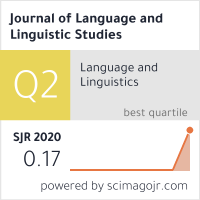A validity and reliability study of the scale of teacher candidate beliefs about Ottoman Turkish
Abstract
The aim of this study is to develop a scale of pre-service teacher beliefs about Ottoman Turkish. The 34-item “The Scale of Teacher Candidate Beliefs about Ottoman Turkish,†created for the piloting was given to 202 pre-service teachers who were taking an Ottoman Turkish course in the departments of Turkish education and Arabic education at Adıyaman University Faculty of Education, to determine the factor structure of the scale. Exploratory and confirmatory factor analyses were performed on the data, and a 14-item scale consisting of alphabet, reading, writing and grammar sub-dimensions was obtained. The total variance explained by the scale was calculated to be 44.69%. The internal consistency value of the Scale of Teacher Candidate Beliefs about Ottoman Turkish was found to be .84. Thus, a functional scale serving the purpose of the study was developed.
Keywords
Full Text:
PDFReferences
Ahmad, F. (2002). The Making of Modern Turkey. London-Newyork.
Al-Ani, S. H. (1970). Arabic Phonology. Paris.
Burrows, G. (2016). The Politics of Arabic Script. Australian National University.
Büyüköztürk, Ş. (2010). Sosyal bilimler için veri analizi el kitabı: İstatistik, araştırma deseni, SPSS uygulamaları ve yorum. Ankara: Pegem Akademi
Calp, M. (2019). An Investigation on The Regulation and Responsibilities of Reading and writing Failures Against Ottoman Turkish Language Students. Kastamonu Education Journal.
Çokluk, Ö., Şekercioğlu, G. ve Büyüköztürk, Ş. (2012). Sosyal bilimler için çok değişkenli istatistik: SPSS ve LISREL uygulamaları. Ankara: Pegem Akademi.
Hooper, D., Coughlan, J., & Mullen, M. R. (2008). Structural equation modelling: guidelines for determining model fit. Electronic Journal of Business Research Methods, 6(1), 53-60.
Jais, M. (2018). Orthographic Transparency the Ottoman Abjad.
Jessen, A. L. (2017). The Sociolinguistic Role of Ottoman Turkish and Arabic Turkish Nationalism. İstanbul: Sabancı Universiity.
Johnson, A. (2004). The Road to Turkish Language Reform and the Rise of Turkish Nationalism. McGill Universitity.
Karadoğan, A. (2017). Arap Harfleri ve Osmanlı Türkçesi. Türk Dili.
McCarthy, J., & McCarthy, C. (2010). Turkey and Turks. Turkish Cultural Foundation.
Melenkaya, K. A., & Zhbannikova, M. I. (2017). Contemporary Turkish Language: Historical- Cultural- Aspects. Ðаучный алманах Ñтран причерноморьÑ.
Tabachnick, B. G., & Fidell, L. S. (2013). Using multivariate statistics. Boston, MA: Pearson Education, Inc.
Yılmaz, K. (2011). Critical Examination of Alphabet and Language Reforms İmplemented in the Early Years of the Turkish Republic. Journal of Social Studies Education Research.
Refbacks
- There are currently no refbacks.

This work is licensed under a Creative Commons Attribution-NonCommercial-NoDerivatives 4.0 International License.
ISSN 1305-578X (Online)
Copyright © 2005-2022 by Journal of Language and Linguistic Studies
